
How To Clean a Smelly Washing Machine
January 11, 2016 | Laundry Appliance Repair, Help & Advice | No comments
Got a smelly washing machine? Musty, mouldy or just generally bad smells coming from your machine are common. The good news is they’re also curable!
We’re here to give you all of the info and advice you need to get your laundry cotton fresh once more!
Why does your washing machine smell?
Washing machines come into contact with a lot of dirt and moisture on a weekly basis so it’s completely normal if yours starts to smell after time.
These are the three main culprits most likely to make you wrinkle your nose.

Mould
Mould loves damp dark crevices so the inside of your washing machine is the ideal environment for mould spores to thrive. When mould grows, musty unpleasant smells aren’t far behind.

Detergent Residue
Detergent build-ups inside your machine are more common in soft water areas. You don’t need to use as much detergent or fabric conditioner when you wash your clothes in soft water so there’s more likely to be undissolved product left in your machine, especially if you use washing powder instead of capsules.
Stale washing detergent combined with the bacteria that’ll soon start growing on it will not be pleasant for your nose!
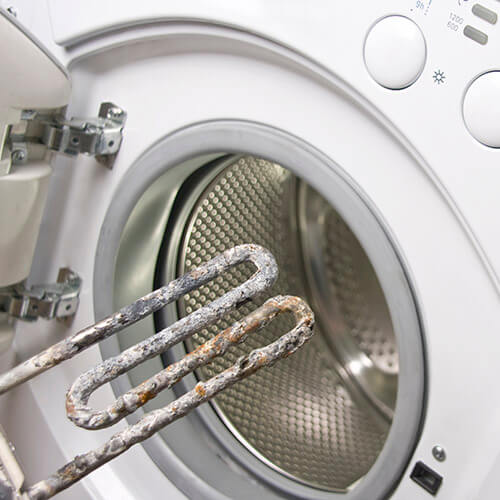
Limescale Deposits
If you live in a hard water area, limescale is the issue you’re more likely to face. Minerals in hard water solidify when they come into contact with the hot parts of your washing machine. This coating of limescale inside your machine is then an ideal breeding ground for bacteria – hence the smell.
How to clean a smelly washing machine
Knowing what’s causing the smell wafting from your washing machine and leaving your clothes less than fresh is all well and good, but how do you get rid of the unwanted odours?
The vast majority of smells can be cured simply by tackling the three Ds: drum, drawer and door.
Clean your washing machine drum
Modern laundry detergents work well, even on lower temperature washes, which means it’s quite common for bacteria to build up inside your machine instead of being flushed out with hot water. As the drum comes directly into contact with your dirty clothes, it can definitely get smelly and stale.
Luckily, the internal parts of your washing machine are really easy to clean. Get your hands on a washing machine cleaner that you pour directly into the drum to remove dirt, detergent build-ups and limescale.
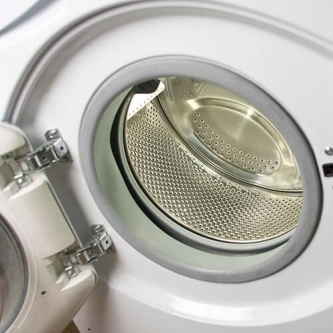
(Shameless plug, our specialist washing machine cleaner and descaler ticks all the boxes and has a rating of 4.8 out of 5 from over 1000 customer reviews.)
Most washing machine cleaners and descalers will follow the same steps:
- Pour the cleaner into the empty washing machine drum.
- Select a hot wash (above 60°C) without pre-wash.
- Run the wash.
Running a monthly maintenance wash with an effective washing machine cleaner lets you keep washing your laundry at lower temperatures and still have a squeaky clean machine. Cooler washes will help keep your utility bills low and benefit our environment too!
Clean your washing machine door and door seal
Cleaning your washing machine door is a two-part job. You’ll need to clean the door itself, but crucially you’ll also need to pay close attention to the rubber door seal.

Cleaning the washing machine door is simple.
- Fill a bowl with hot water.
- Add washing up liquid.
- Wipe the glass clean with a cloth or sponge.
- Dry the door thoroughly using a clean tea towel.
You can also use washing up liquid and hot water to clean the door seal too. Just dip an old toothbrush into a bowl of hot, soapy water and scrub the seal until the dirt has been removed from the surface. You’ll need to pull the folds apart to really get into the crevices for cleaning.
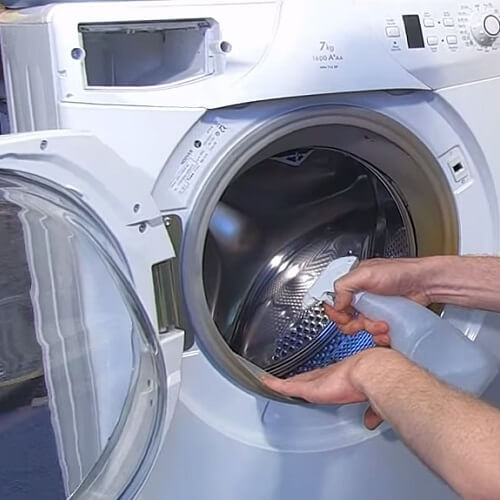
However, for stubborn or large amounts of mould, we recommend using a cleaning spray that’s designed to tackle mould and mildew.
- Spray the cleaner into the folds of the door seal.
- Leave it to soak in for 10 mins (or the time recommended on the packaging).
- Scrub the seal clean with a scouring pad.
- Wipe with a damp cloth.
- Use a clean tea towel to dry the seal.
If the mould around the door seal is still not coming off after scrubbing it may have stained the rubber. Old, discoloured seals can be replaced and if you also notice any cracks, loose parts or damage to your seal we definitely recommend doing so. Otherwise, you’ll soon have a leaky washing machine on your hands.
Watch our resident appliance expert Matt take you through a washing machine door seal replacement step-by-step:
Clean your washing machine soap drawer and drawer housing
Unless you clean it very diligently and regularly, the drawer for detergents and fabric softener in your washing machine is almost guaranteed to have some mould in it. It’s dark, it’s damp and it’s the perfect place for black mould to thrive.
Giving this area of your machine a once over every now and again doesn’t just get rid of any potential bad smells, but also stops the water jets that spray into the drawer from getting blocked or clogged.
Mould is not great for your health, especially if you have allergies, so cleaning this area of your washer regularly is highly recommended.

Step 1 – Remove the drawer
For a thorough clean, you’ll need to remove the soap drawer from your machine. Your manual will show you how, but it can usually be taken out one of two ways:
- Press the release clip (which is commonly found on Balay, Bosch, Neff, Siemens and Zanussi machines).
- Give the drawer a firm pull. However, if you’re sensing excessive resistance, double check your manual as you don’t want to break it!
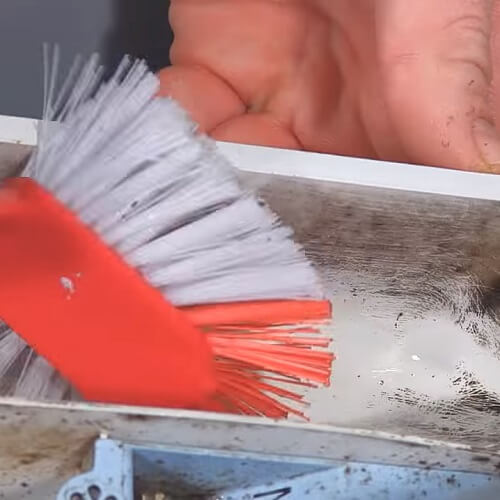
Step 2 – Clean the drawer
The drawer itself can be washed up in the sink using hot water, washing up liquid and an old dishwashing brush to get into all the crevices. Make sure to clean the underneath of the drawer as well as the compartments on top.
Once you’ve cleaned it, leave the drawer to dry on your draining board.
Some washing machines also have a removable tube to deliver fabric softener into the drum which you can remove and clean in the same way.
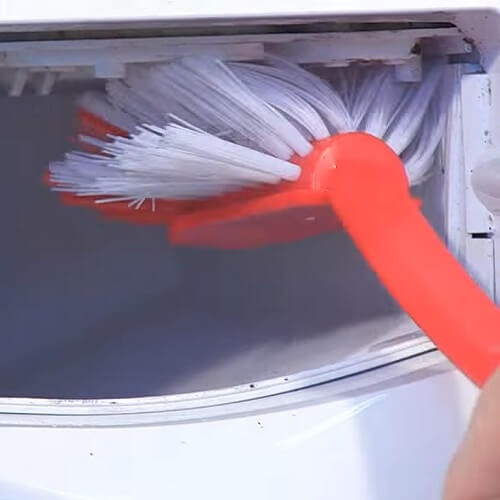
Step 3 – Clean the drawer housing
While the drawer is drying, you can tackle the housing where the drawer came from.
- Spray plenty of dedicated washing machine cleaner, mould remover or vinegar into the housing depending on your preference.
- Use an old dishwashing brush to scrub the whole area and loosen all of the mould and built-up detergent.
- Spray water around the area to rinse it, then wipe down with kitchen towel or a clean tea towel.
- Once the area has been cleaned, leave it to naturally air dry before placing the drawer back into it.
See Matt demonstrate a thorough washing machine clean in action:
Other potential problems causing a smelly washing machine
Blocked filter
The filter in your washing machine stops debris from your wash (like tissue fluff or coins left in your pockets) from getting into the pump and damaging it.
If your filter’s clogged up it can stop your machine from draining properly, meaning there may be some stagnant water left inside it. The result: a very smelly washing machine!

If you suspect this issue:
- Switch off and unplug your machine
- Flip the filter catch open. You’ll usually find it at the front of your washing machine near the base.
- Unscrew the filter cap. You shouldn’t need tools for this, just your hands.
- Pull the filter out. As you remove the filter, water may follow, so pop a towel down on the floor first to soak up any spills.
- Remove any debris from the filter and rinse it to clean it.
- Before you pop your filter back in, feel around in the filter housing too to check there are no obstructions, tangles or debris build-ups there.
- Replace the filter and close the filter catch.
If you can’t easily get the filter hatch open, consult your manual as not all washing machine models allow you easy access to the filter in this way.
Dirty drain hose
The drain hose transports the dirty water out of your washing machine. If your machine is having draining issues as well as smelling and you’ve already checked the filter, check the drain hose next. It’s the larger of the two hoses that connect the back of your appliance to the plumbing under your sink.
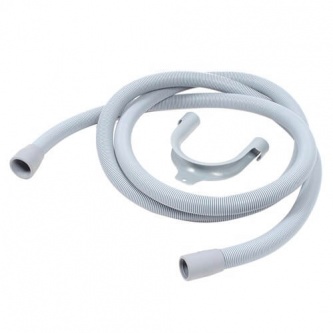
To investigate:
- Switch off and unplug your machine.
- Put a towel down under your sink to catch excess water.
- Detach the drain hose.
- Check the hose for any kinks and straighten if necessary.
- Use a torch to look inside the hose and feel down the length of it for blockages.
- Use a plastic coat hanger to dislodge any blockages.
Smelly sink or drain
If none of the above has worked for you, it’s possible that the bad smell isn’t coming from your washing machine at all. It could be a smelly sink or drain that’s to blame.
- Clean out your sink plumbing with a sink cleaner that removes fatty residue and blockages.
- Clean your drain by pouring a cup of white vinegar and a cup of baking soda down it.
How to avoid washing machine smells in future
Once you’ve cured your smelly washing machine, we’re sure you’d like to keep it clean and fresh smelling!
 Follow these steps to help your appliance stay fresher for longer:
Follow these steps to help your appliance stay fresher for longer:
- Leave the door and drawer of your washing machine ajar after a wash to help it air out and dry off.
- Use less detergent or fabric softener, especially if there’s soap residue left over after your washes.
- Let extremely muddy or dirty clothes dry off so you can beat the worst of the dirt off them before putting them in your machine.
- Dry your laundry outside wherever you can as sunshine helps to kill bacteria and encourage freshness.
Which products get rid of washing machine smells the best?
As we’ve mentioned a few different cleaning products, we’ve put together some pros and cons to help you choose how to clean your machine.
| Product | Pros | Cons | Suggested Use |
White vinegar |
– Cheap – Natural – Common household product |
– Not as effective as specialist cleaning products – Strong smell |
A handy substitute when you don’t have specialist cleaning products available |
Hot water and washing up liquid |
– Cuts through grease – Fresh smelling – Common household product |
– Doesn’t remove limescale – Doesn’t kill mould |
Doors and drawers |
Mould and mildew remover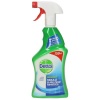 |
– Designed specifically to tackle mould – Can help to control re-growth |
– Doesn’t remove limescale – Contains stronger chemicals |
Mouldy door seals and drawer housing |
Washing machine cleaner and descaler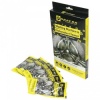 |
– Most effective for both limescale and detergent build-ups – Easy to use |
– Usually comes in powder form (but can be dissolved in water to use as a spray) | Drum and internal parts |
With that, your knowledge about cleaning your smelly washing machine is complete!
Putting some time aside for regular cleaning doesn’t just get rid of nasty niffs. Removing limescale, blockages and excess detergent will help your washing machine last longer, which in the long run will save you money!
Now that you know how to keep your machine clean, find out whether you’re washing your household items as often as you should be.
Tags: Cleaning Tips, Smelly Washing Machine, Washing Machine

